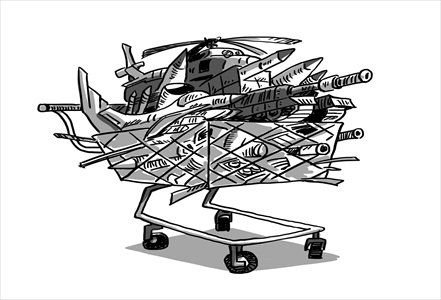Russia-India arms deal not aimed at China

The recent visit by Russian President Vladimir Putin to India attracted the attention of policymakers, experts and mass media because of the new arms deals that were signed. Under the agreement, Russia will supply 71 helicopters and technology for licensed assembling of 42 advanced combat planes worth $2.9 billion.
These agreements raised some concerns from neighboring countries about the implications of the arms deals. Are Russian arms sales aimed at heightening tension between China and India?
There are some points which need to be made. First, the strategic goal of Russian foreign policy is to peacefully leave the out-of-date unipolar world and promote the development of a multipolar one.
Being members of BRICS and G20, China, India and Russia are pillars of the evolving multipolar world. The official National Security Strategy of the Russian Federation to 2020 stated that Russia will facilitate the involvement of other states and first of all nuclear ones as well as those interested in joint actions to ensure general security in the process of ensuring strategic stability.
Both China and India fall into the nuclear power category and bear responsibility for regional stability. It is not in Russian interests for these two countries to clash.
Second, the center of world politics has been drifting to the Asia-Pacific region. The National Military Strategy of the United States of America (2011) states, "The Nation's strategic priorities and interests will increasingly emanate from the Asia-Pacific region. The region's share of global wealth is growing, enabling increased military capabilities. This is causing the region's security architecture to change rapidly, creating new challenges and opportunities for our national security and leadership."
To preserve its dominant position in the region, the US has begun to rebalance its global posture toward the Pacific to constrain China's rise and to control India's.
Third, according to the draft of the new Russian foreign policy concept under the conditions of global turbulence and growing interdependence, states do not have prospects for building separate oases of tranquility and security.
In this context, Russia can play a stabilizing role in relations between China, India and the US. For Russia, it is important to preserve and to develop political, economic and humanitarian ties with China and India.
While in India, President Putin indicated the goal of raising the bilateral foreign trade volume from the current $10 billion to $20 billion by 2015. The number is not that big compared to the current trade volume of $70 billion between China and India.
Long-term beneficial cooperation between Russia and India goes back to the Soviet Union era. The official status of the relations is called a "privileged strategic partnership."
For Russia, India has been a very important arms trading partner for decades. Through the 1990s, when Russia went through a severe economic crisis, military exports to India as well as to China made a crucial contribution to the survival of the Russian defense industry. To a great extent, these arms supplies remain significant today.
In 2011, Russian arms deals with India brought $3.6 billion, which make up 27 percent of profit for Russia's state-run weapon trading company Rosoboronexport. Between 2000 and 2010, Russia and India signed arms deals worth $30 billion.
Nevertheless, it would be a distorted picture of the Russian-Indian partnership if one focused only on arms sales. During President Putin's visit, the Indian Prime Minister Manmohan Singh stated, "The development of our nuclear energy program has been a key pillar of our strategic partnership. Construction of Unit 1 of the Kudankulam Nuclear Power Project is now complete, and power generation will commence shortly." Singh also said, "We look forward to the completion of Unit 2 next year. Negotiations for the construction of Units 3 and 4 at Kudankulam have made good progress."
Arms deals are not a geopolitical game for Russia. Russian GDP in 2012 grew by 3.5 percent compared with 4.3 percent in 2011. The slowing pace of the Russian economy is the consequence of its mineral resources-based economic model. It is vital for Russia to develop those sectors of its national industry that meet high standards of advanced world economies. Today they are the defense industry, space and peaceful nuclear energy.
In the political field, Russia and China have close or similar positions on many issues, including Libya and Syria. That is why developing fruitful economic cooperation with India as well as with China makes it possible to build a modern Russian economy and to create a prosperous interdependent multipolar world.
The author is chair of the Political Science Department at the Diplomatic Academy in Moscow. opinion@globaltimes.com.cn